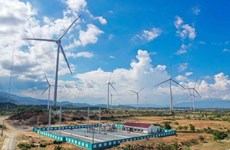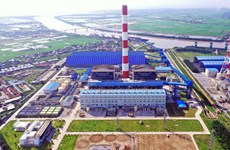Rubber exports reach record high of 3 billion USD
A Vietnam's rubber export value last year reached a record high of 3.1
billion USD, with about 800,000 tonnes of rubber exported, according to
the Vietnam Rubber Association (VR).
A Vietnam's rubber export value last year reached a record high of 3.1
billion USD, with about 800,000 tonnes of rubber exported, according to
the Vietnam Rubber Association (VR).
The figure represented an increase of 2.2 percent in volume and more than 31 percent in value, said Tran Thi Thuy Hoa, VRA's general secretary.
Speaking at a conference in HCM City last week, Hoa said despite rubber prices falling by 30-40 percent in the later months of the year, the average export price last year was higher, about 3,900 USDa tonne, than the average price in 2010.
To reduce dependence on the Chinese market, rubber exporters last year tried to increase exports to the EU and the US, but demand from those two markets had reached a saturation point, she said.
As a result, China remained a key market for Vietnamese rubber, accounting for 60 percent of the country's total rubber exports currently compared to 70 percent in 2010.
Last year the rubber industry encountered many difficulties due to the global economic downturn.
In addition, disasters in Japan and Thailand seriously affected the local tire manufacturing, lowering demand for natural rubber.
In the domestic market, high interest rates and theft of goods from containers meant lower exports and a shortage of raw materials.
The rubber industry this year expected to export as much rubber as last year, Hoa said, adding that with the current situation, export prices would probably not return to the highest price that occurred in early 2010.
However, the price will not drop to below the production costs because Thailand, Indonesia, Malaysia and Vietnam, the world's four largest rubber exporters, agreed to maintain the price of rubber stable to ensure profits for growers.
Demand for natural rubber might fall in the short term, but in the long term demand is expected to grow steadily.
Hoa said the industry this year would make more efforts to promote the Vietnamese rubber brand in the world market and work with research institutes, businesses and farmers to improve rubber quality.
The country has about 740,000 ha of rubber plantations, mainly located in southeastern provinces. It ranks fifth in the world in rubber cultivation area after Thailand, Indonesia, Malaysia and India.
The Government has created a master plan to develop the industry until 2015 with a vision to 2020.
Under the plan, the country targets having 800,000ha under rubber cultivation by 2015, producing more than 1.2 million tonnes of natural rubber per year by 2020./.
The figure represented an increase of 2.2 percent in volume and more than 31 percent in value, said Tran Thi Thuy Hoa, VRA's general secretary.
Speaking at a conference in HCM City last week, Hoa said despite rubber prices falling by 30-40 percent in the later months of the year, the average export price last year was higher, about 3,900 USDa tonne, than the average price in 2010.
To reduce dependence on the Chinese market, rubber exporters last year tried to increase exports to the EU and the US, but demand from those two markets had reached a saturation point, she said.
As a result, China remained a key market for Vietnamese rubber, accounting for 60 percent of the country's total rubber exports currently compared to 70 percent in 2010.
Last year the rubber industry encountered many difficulties due to the global economic downturn.
In addition, disasters in Japan and Thailand seriously affected the local tire manufacturing, lowering demand for natural rubber.
In the domestic market, high interest rates and theft of goods from containers meant lower exports and a shortage of raw materials.
The rubber industry this year expected to export as much rubber as last year, Hoa said, adding that with the current situation, export prices would probably not return to the highest price that occurred in early 2010.
However, the price will not drop to below the production costs because Thailand, Indonesia, Malaysia and Vietnam, the world's four largest rubber exporters, agreed to maintain the price of rubber stable to ensure profits for growers.
Demand for natural rubber might fall in the short term, but in the long term demand is expected to grow steadily.
Hoa said the industry this year would make more efforts to promote the Vietnamese rubber brand in the world market and work with research institutes, businesses and farmers to improve rubber quality.
The country has about 740,000 ha of rubber plantations, mainly located in southeastern provinces. It ranks fifth in the world in rubber cultivation area after Thailand, Indonesia, Malaysia and India.
The Government has created a master plan to develop the industry until 2015 with a vision to 2020.
Under the plan, the country targets having 800,000ha under rubber cultivation by 2015, producing more than 1.2 million tonnes of natural rubber per year by 2020./.











